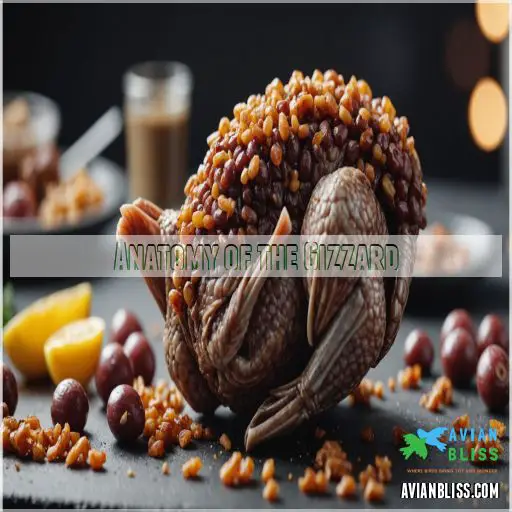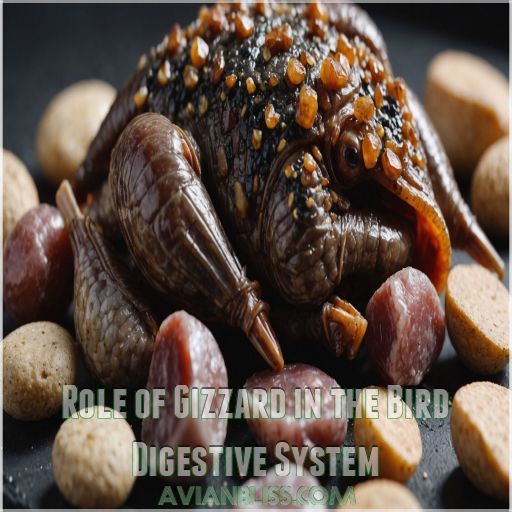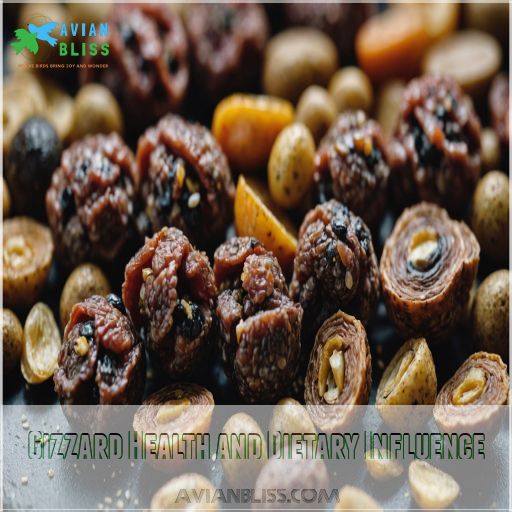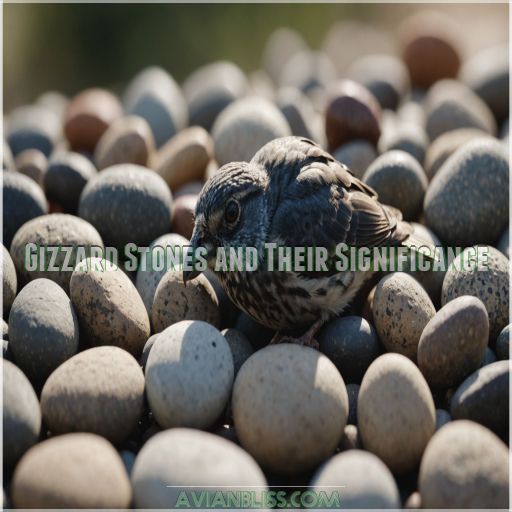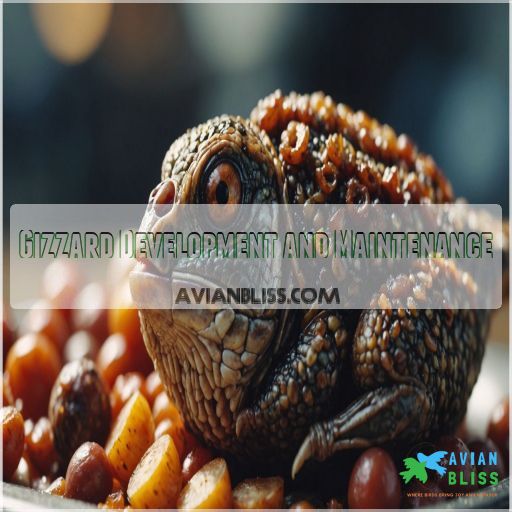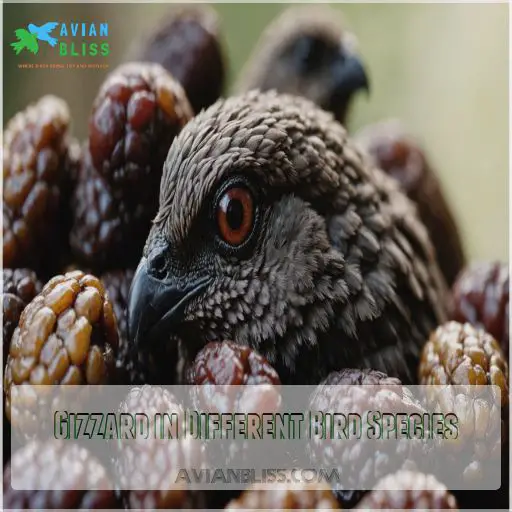This site is supported by our readers. We may earn a commission, at no cost to you, if you purchase through links.
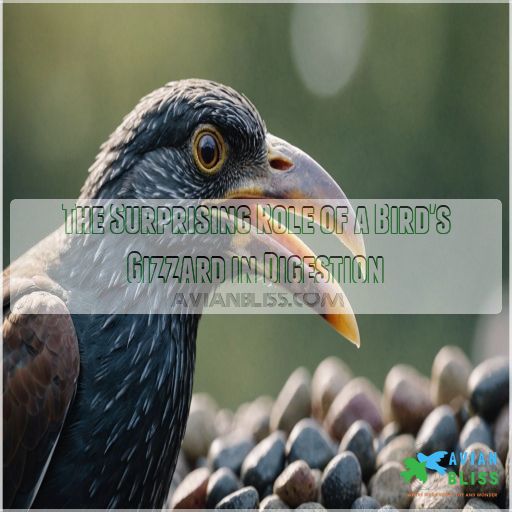
The gizzard’s tough walls and gritty lining work like a mill, crushing seeds and insects into digestible bits. Birds even swallow small stones to help with the grinding! It’s not just about breaking down food; the gizzard also preps meals for chemical digestion and nutrient absorption.
From hummingbirds to ostriches, every bird’s got one, but they’re not all created equal. Some gizzards are real heavyweights, while others are more laid-back.
Table Of Contents
- Key Takeaways
- Anatomy of the Gizzard
- Function of the Gizzard
- Role of Gizzard in the Bird Digestive System
- Gizzard Health and Dietary Influence
- Gizzard Stones and Their Significance
- Comparative Analysis Across Bird Species
- Gizzard Development and Maintenance
- Gizzard in Different Bird Species
- Unique Features of the Gizzard
- Frequently Asked Questions (FAQs)
- What is the function of the gizzard in a bird?
- What is a gizzard and how does it work?
- What does the gizzard do in an earthworm?
- Do humans have a gizzard?
- Do you eat the gizzard?
- Why birds have a gizzard while humans do not?
- What is gizzard made of?
- Can birds regurgitate gizzard contents like owls do?
- How does gizzard size vary across bird species?
- Do all birds need grit for their gizzards?
- Can gizzards in birds regenerate if damaged?
- How do gizzards affect a birds dietary choices?
- Conclusion
Key Takeaways
- You have a built-in food processor in your feathered friends, particularly when consuming millet as a seed
! The gizzard is a muscular stomach that grinds food with the help of small stones, compensating for birds’ lack of teeth.
- It’s not a one-size-fits-all situation in the bird world. Gizzard size and strength vary based on diet, from seed-crunching powerhouses to delicate fruit processors, showcasing nature’s knack for custom-built digestive tools.
- Your bird’s gizzard is pulling double duty. Not only does it break down food, but it also plays a role in maintaining flight balance, acting like nature’s built-in gyroscope to keep birds steady as they soar.
- You can’t judge a bird by its beak alone. The gizzard’s adaptations to specific diets and environments have been crucial in bird evolution, allowing them to thrive on diverse food sources without needing heavy chompers.
Anatomy of the Gizzard
When you think about a bird’s stomach, you’d probably picture something soft and gooey, but the gizzard’s more like a muscular powerhouse with a job to grind food.
Tucked between the esophagus and small intestine, this disc-shaped organ relies on strong muscles and a gritty lining called koilin to break down meals, doing the heavy lifting before your feathery friend gets to savor its nutrients.
Location in the Digestive Tract
Imagine this: the gizzard sits snugly in the middle of a bird’s digestive highway, between the crop and intestines. It’s like a rest stop where food gets a workout, with the help of gastroliths, or ingested stones, which act like teeth to grind food. This unique system also relies on the gizzard’s muscular strength to efficiently break down tough foods.
The gizzard placement allows:
- Effective digestive tract flow.
- Connection between esophagus and intestines.
- Efficient avian digestive system function.
- Efficient gizzard anatomy for grinding food.
Physical Structure and Composition
Having located the gizzard in a bird’s digestive tract, let’s explore its anatomy.
Imagine a sturdy, muscular pouch tasked with grinding food. The gizzard’s size, shape, and internal structure are perfectly designed for this job.
Stones often assist its muscular walls. It houses a fascinating koilin lining, which sometimes sounds like a tongue twister.
Gizzard Wall Muscles and Koilin Lining
Imagine the gizzard working like a muscular powerhouse, with strong muscles crushing food thanks to the gizzard muscle types.
You can visualize the tough koilin lining as a trusty protective shield.
This specialized lining enhances muscle strength but also safeguards against gizzard ailments, showcasing brilliant gizzard evolution and efficient gizzard function.
Function of the Gizzard
When you think about a bird squeezing food into tiny bits, you might imagine it chewing with its non-existent teeth.
But in reality, the gizzard—a bird’s own food processor—uses muscle power and a gritty diet to break down meals, preparing everything for the next stage of digestion.
Mechanical Digestion and Food Pulverization
The gizzard’s role in mechanical digestion is quite fascinating. You might compare it to a food processor, using grit selection and gizzard muscles to pulverize food.
Grit aids in breaking down food. Strong muscles crush it further. Koilin lining boosts efficiency.
This clever adaptation helps with efficient digestion and nutrient absorption .
Preparation for Chemical Digestion
You may not realize it, but your feathered friend’s gizzard plays a major role in preparing their food for chemical digestion.
This muscular stomach chamber grinds and softens the food, making it more accessible for the digestive enzymes to work their magic.
The gizzard’s acidic environment also helps regulate the pH, optimizing conditions for nutrient absorption in the small intestine.
Role in Increasing Surface Area for Enzyme Contact
Think of the gizzard as nature’s blender, breaking down food to increase surface area for enzyme contact, boosting digestion efficiency.
Those tiny, pulverized bits help your bird buddy get the most out of each meal, optimizing nutrient absorption and reducing avian waste.
In the chicken digestive tract, it’s important for high-energy needs and preventing issues like necrotic enteritis.
- Boosts enzyme efficiency
- Improves nutrient absorption
- Reduces waste production
Role of Gizzard in the Bird Digestive System
You might think a bird’s digestive process is straightforward, but the gizzard plays a key secret role, connecting the esophagus to the small intestine, much like how seed digestive benefits aid in breaking down tough shells
.
It’s like the bird’s own blender, working alongside other organs to make sure food is ready for nutrient absorption.
Connection to the Esophagus and Small Intestine
Imagine the gizzard as a bustling kitchen, where the Esophagus-Gizzard Connection is like a conveyor belt delivering ingredients.
From this efficient grind house, food swiftly moves into the small intestine.
At this stage, Food Passage Timing makes sure nutrients meet digestive enzymes perfectly, while the Gizzard-Intestine Connection keeps the process flowing like a well-oiled machine.
Importance in the Digestive Process
After the esophagus, the gizzard leaps into action, pulverizing food with grit, like a tiny blendtec in a bird’s belly.
This muscular marvel enhances digestive efficiency by increasing surface area for enzyme activity, ensuring nutrients are well absorbed.
Without this process, even Canada geese and bearded tits might struggle with bacterial, fungal, or viral infections.
Interaction With Other Digestive Organs
Picture a gizzard-esophagus connection as the start of a digestive dance. Food flows seamlessly from the gizzard to intestine, interacting with other organs.
The gizzard, key for breaking down food, teams with pancreatic juice for digestion, eventually reaching the large intestine.
In this thoracoabdominal cavity, even red knot birds benefit, filtering nutrients while calmly skirting uric acid complications.
- Esophagus Connection: Essential first step.
- Intestinal Flow: Smooth transition.
- Pancreatic Partnership: Digestive collaboration.
- Large Intestine Journey: Waste processing.
- Thoracoabdominal Setting: Intricate balance.
Gizzard Health and Dietary Influence
When you think about a bird’s gizzard, it’s easy to picture a tiny gym for food, working out those tough meals into digestible bits.
But if birds snack on poor-quality food or accidentally gobble up foreign objects, they can face serious gizzard troubles, which can be compared to a human’s tummy ache.
Effect of Diet on Gizzard Size and Strength
Your bird’s diet plays a starring role in its gizzard’s size and strength.
Hard foods, like seeds, act like nature’s gym equipment, beefing up the gizzard muscles. You’ll see larger gizzards in birds chowing down on tough grub, while soft food fans sport smaller ones.
It’s an evolutionary adaptation that’s all about efficiency. A strong gizzard equals a healthy bird! This concept is also related to the idea of nature’s gym equipment.
Common Gizzard Ailments and Impactions
While a healthy diet keeps your bird’s gizzard in top shape, sometimes things go south, especially with an all-seed diet option
.
Gizzard impactions can turn your feathered friend’s digestive powerhouse into a traffic jam. Watch for signs like weight loss, lethargy, and a pasted vent.
These gizzard gremlins often stem from overeating fibrous materials or small objects.
Don’t chicken out – proper grit and a balanced diet are your best bets for preventing these pesky problems.
Impact of Poor-Quality Food and Foreign Bodies
Ever wondered how a bird’s gizzard handles a bad meal? It’s not pretty!
Poor-quality food and foreign bodies can wreak havoc on gizzard health, leading to impaction .
You might think birds have iron stomachs, but they’re more like finicky food processors.
Ingesting string, grass, or even plastic can cause a traffic jam in their digestive tract.
It’s like trying to shove a sweater through a paper shredder – nothing good comes of it!
Gizzard Stones and Their Significance
Ever wondered why birds seem to enjoy a side of pebbles with their meals?
These tiny rocks, known as gizzard stones, play a key role in grinding up food and releasing essential minerals.
Like calcium, making them nature’s built-in food processor for our feathered friends.
Selection and Use of Gizzard Stones
Pecking at gravelly surfaces, birds aren’t just being picky eaters – they’re selecting their digestive helpers . You’d be amazed at how these feathered friends choose their gizzard stones.
- Grit size: Suited to fit their gizzard’s grinding needs
- Stone composition: Favoring hard, acid-insoluble rocks like quartz
- Mineral content: Some birds prefer calcium-rich stones for added nutritional benefits, like the calcium found in chicken feed
Talk about killing two birds with one stone – these gastroliths grind food and provide essential minerals!
Replacement Cycle and Importance of Stones
You’ve seen how birds pick their grit, but let’s talk about the rock ‘n’ roll world inside their gizzards. These tiny stomach stones aren’t permanent residents – they’re constantly on the move! As birds grind away, their gizzard stones wear down and need replacing. It’s like a never-ending game of musical chairs for pebbles.
| Stone Size | Grinding Power | Bird’s Reaction |
|---|---|---|
| Too small | Weak sauce | "Meh, I’m hungry" |
| Just right | Pulverizing pro | "Now we’re talking!" |
| Too big | Stomach ache | "Ouch, my tummy!" |
| Worn out | Ineffective | "Time for new rocks!" |
| Perfect mix | Digestion dream | "I feel invincible!" |
The size and mix of these stones can make or break a bird’s day . So next time you see a bird pecking at the ground, remember – they might just be shopping for their next set of stomach grinders!
Release of Vital Minerals Like Calcium
Those little rocks in a bird’s gizzard aren’t just for grinding. They’re like a mineral buffet! As gizzard stones break down, they release important calcium that’s absorbed into the bird’s system. This sneaky calcium boost helps prevent deficiencies and keeps bones strong.
- Improves egg shell quality
- Enhances chick development
- Supports overall bone health
- Aids in mineral absorption
Talk about killing two birds with one stone – or should we say, one grit?
Comparative Analysis Across Bird Species
You’ll find that gizzards aren’t one-size-fits-all in the bird world.
From seed-crunching powerhouses to delicate fruit processors, birds’ gizzards have evolved to match their diets.
They showcase nature’s knack for perfectly adapted design.
Variations in Gizzard Structure and Function
Now that we’ve explored gizzard stones, let’s look at how gizzards themselves vary across bird species.
It’s like birds have their own unique food processors! Gizzard size and muscle strength can differ dramatically, depending on a bird’s diet.
Granivorous birds, for example, often have larger, more muscular gizzards to grind tough seeds, while frugivores tend to have smaller, less robust gizzards.
This variety in gizzard structure showcases nature’s knack for tailoring digestive tools to specific dietary needs.
Evolutionary Adaptations to Diet and Environment
Birds’ gizzards are marvels of evolutionary engineering, adapting to diverse diets and environments.
Gizzard size often correlates with food hardness – seed-eaters boast larger, more muscular gizzards than fruit-eaters . Beak shape and gizzard strength work in tandem, reflecting dietary specializations.
In resource-scarce habitats, some birds develop more robust gizzards to extract maximum nutrition. These adaptations showcase nature’s clever trade-offs, balancing energy expenditure with nutrient acquisition.
It’s like having a custom-built food processor in your belly, a reflection of nature’s clever trade-offs.
Relationship Between Gizzard and Flight Balance
While you might think a bird’s gizzard is just for digestion, it’s actually a key player in flight balance.
As the heavyweight of the digestive system, gizzard size and weight have a big impact on a bird’s center of gravity.
Evolution’s balancing act has fine-tuned gizzard mass to body size, ensuring great flight stability.
It’s like nature’s built-in gyroscope, keeping our feathered friends steady as they soar through the skies.
Gizzard Development and Maintenance
You might think a bird’s gizzard just appears fully formed, but it’s actually a complex organ that develops and changes throughout a bird’s life.
From the moment a chick hatches, its gizzard grows and adapts to its diet, playing a key role in keeping our feathered friends healthy and well-fed, which is why offering a nutritious treat like chia seeds is important for a healthy bird
.
Factors Affecting Gizzard Growth and Development
Ever wonder what makes a bird’s gizzard grow? It’s like a muscle-building gym for birds!
Your feathered friend’s diet plays a starring role (Source). Chowing down on coarse fibers can beef up the gizzard by a whopping 182% .
Age, genetics, and environment are also key players in this digestive drama. Even stress can throw a wrench in the works, affecting how this mighty organ develops and functions.
Importance of Gizzard Maintenance and Health
Now that you’ve got the lowdown on gizzard growth, let’s talk about keeping that belly-grinder in tip-top shape.
Your feathered friend’s gizzard health is no joke – it’s the powerhouse of their digestion!
Proper grit selection is key; those little stones are like nature’s food processor .
A balanced diet isn’t just for humans – it’s a game-changer for your bird’s gizzard too.
Remember, a happy gizzard means a healthy bird!
Impact of Gizzard Impactions on Overall Health
A blocked gizzard can throw a wrench in your bird’s digestive works.
Gizzard impactions often lead to anorexia, lethargy, and weight loss . You’ll want to watch out for these red flags to keep your feathered friend healthy.
Impactions can stem from fibrous materials, sand, or even rubbish. To prevent this gizzard gridlock, provide proper grit and keep an eye on what your bird’s pecking at.
Your birdie’s health is in your hands, and it’s crucial to take care of it to prevent a gizzard gridlock.
Gizzard in Different Bird Species
You’ll find gizzards in all bird species, but they’re not created equal.
From the rock-crushing powerhouse of a turkey to the dainty grinder of a hummingbird, a bird’s gizzard is adapted to its diet, showing nature’s knack for custom-built digestive tools.
Examples of Birds With Well-Developed Gizzards
You’ve heard about gizzard maintenance, but let’s talk about the heavy hitters in the gizzard game. Some birds have gizzards that could put a bodybuilder to shame! Take a gander at these muscular marvels: birds like pigeons and doves also consume gravel to aid in the digestion of seeds and plant material. This helps to break down tough seeds and grains, making it an essential part of their digestive process.
- Chickens: The original gizzard grinders
- Turkeys: Pecan-crushing powerhouses
- Ducks: Shellfish-smashing specialists
- Geese: Nature’s nutcrackers
These birds’ gizzards are like built-in food processors, pulverizing seeds, nuts, and shellfish with ease. It’s like they’ve got a tiny rock tumbler in their belly!
Examples of Birds With Less Muscular Gizzards
Hummingbirds, nectar-feeding birds, and other soft-billed species often have less muscular gizzards compared to their seed-eating counterparts.
This adaptation allows them to efficiently process their liquid or soft diets without the need for extensive mechanical breakdown.
Their gizzards are smaller and less developed, focusing more on chemical digestion .
Adaptations to Specific Diets and Environments
Birds are nature’s culinary wizards, adapting their gizzards to suit their diets and habitats.
Take the seed-loving finch – its muscular gizzard grinds tough seeds like a built-in mortar and pestle.
On the flip side, fish-eating herons have smaller, less muscular gizzards since their slippery meals don’t need much grinding. It’s like having a kitchen appliance designed for your favorite cuisine!
Unique Features of the Gizzard
You might think a bird’s gizzard is just another digestive organ, but it’s a marvel of evolution with some truly unique features.
This muscular powerhouse acts like a set of built-in teeth, grinding up food with the help of swallowed stones and a tough inner lining that’d make a jackhammer jealous.
Distinct Characteristics of the Gizzard
Let’s take a closer look at the gizzard’s unique features.
This muscular powerhouse of digestion packs quite a punch! With its thick walls and koilin layer, it’s like a built-in food processor.
You’ll find grit inside, acting as nature’s teeth for grinding.
The gizzard’s size and strength vary based on diet, adapting to different nutritional needs . It’s a prime example of nature’s ingenuity in solving the toothless bird’s dilemma.
Importance of the Gizzard in Bird Evolution
The gizzard’s role in bird evolution is nothing short of revolutionary.
As birds lost their teeth over time, which was largely driven by genetic mutations that blocked tooth development around 100 million years ago ancient bird ancestors with teeth, the gizzard stepped up to the plate, becoming a powerhouse of mechanical digestion.
This muscular marvel allowed birds to adapt to diverse diets, from seeds to insects, without the need for heavy chompers.
It’s like trading in your old blender for a state-of-the-art food processor – more efficient and way cooler!
Comparison to Other Digestive Organs in Birds
While other organs play their part, your feathered friend’s gizzard is the true MVP of digestion.
Unlike the crop’s storage role or the beak’s initial crushing, this muscular powerhouse grinds food to a pulp.
It’s like having a set of built-in teeth! The gizzard outshines the stomach and intestines in mechanical breakdown, preparing food for the best nutrient absorption.
Talk about a gut-busting workout!
Frequently Asked Questions (FAQs)
What is the function of the gizzard in a bird?
Think of a bird’s gizzard as nature’s food processor, like the way birds adapt their diets seasonally
.
It’s a muscular stomach that grinds food using small stones.
You’ve got teeth, but birds have this built-in grinder to pulverize seeds and nuts.
What is a gizzard and how does it work?
Did you know birds can crush food with 100 times the force of their body weight?
That’s your gizzard at work!
It’s a muscular stomach that grinds tough foods using small stones.
Nature’s built-in food processor!
What does the gizzard do in an earthworm?
You’ve got a built-in grinder in your earthworm.
The gizzard, a muscular organ, uses tiny stones to pulverize soil and organic matter (Source).
It’s like a mini food processor, breaking down nutrients for easy absorption.
Do humans have a gizzard?
Contrary to birds, your digestive system doesn’t include a grinding gizzard.
Instead, you’ve got a muscular stomach that churns food with enzymes.
Your teeth do the initial grinding, breaking down food before it reaches your gut.
Do you eat the gizzard?
Gizzards are edible and packed with protein.
You can braise them for a rich, meaty flavor or deep-fry for a crispy treat.
They’re chewy but nutritious, offering a unique taste experience for adventurous eaters.
Why birds have a gizzard while humans do not?
Picture a bird’s stomach as a built-in food processor.
Birds evolved gizzards to grind tough seeds and nuts, compensating for their lack of teeth.
Humans, with our chompers and hands, don’t need this muscular grinding pouch for digestion.
What is gizzard made of?
The gizzard’s a tough cookie in a bird’s belly.
It’s got thick muscular walls and often contains small stones.
This grinding powerhouse breaks down food like your teeth would, turning seeds into bird fuel.
Can birds regurgitate gizzard contents like owls do?
Like nature’s own recycling system, many birds can regurgitate gizzard contents.
While owls are famous for their pellets, other species also expel indigestible material from their gizzards.
This behavior is shared among various bird species, including crows, gulls, and even some songbirds (Source).
How does gizzard size vary across bird species?
Gizzard size varies widely across bird species, generally scaling with body mass.
Larger birds often have bigger gizzards to process more food.
This relationship isn’t absolute, though – diet and feeding habits also influence gizzard size .
Do all birds need grit for their gizzards?
Imagine a bird’s stomach as a tiny rock tumbler.
Not all feathered friends need grit.
Seed-eaters and some others benefit from these natural grinding stones, while soft food eaters don’t require this digestive aid.
Can gizzards in birds regenerate if damaged?
Birds’ gizzards can heal from minor damage, but severe injuries may not fully regenerate.
The gizzard’s tough koilin layer can repair itself, but extensive harm could impair function.
Regular check-ups help keep your feathered friend’s digestive health in good shape.
How do gizzards affect a birds dietary choices?
Picture a stone-grinding mill in a bird’s belly.
Your gizzard’s strength shapes your menu choices.
You’ll gobble up grit to help grind tough seeds and shells, while softer foods might leave you craving a good crunch.
Conclusion
Holy crow, the gizzard’s not just some random bird part! It’s a key player in avian digestion, grinding away like a champ.
Next time you’re pondering "what is a gizzard in a bird," remember it’s their built-in food processor, adapting to diets from seeds to insects.
This muscular marvel preps meals for nutrient absorption, proving birds don’t need teeth to thrive.
Whether you’re a backyard birdwatcher or a budding ornithologist, understanding the gizzard gives you a fresh perspective on our feathered friends’ incredible adaptations.

